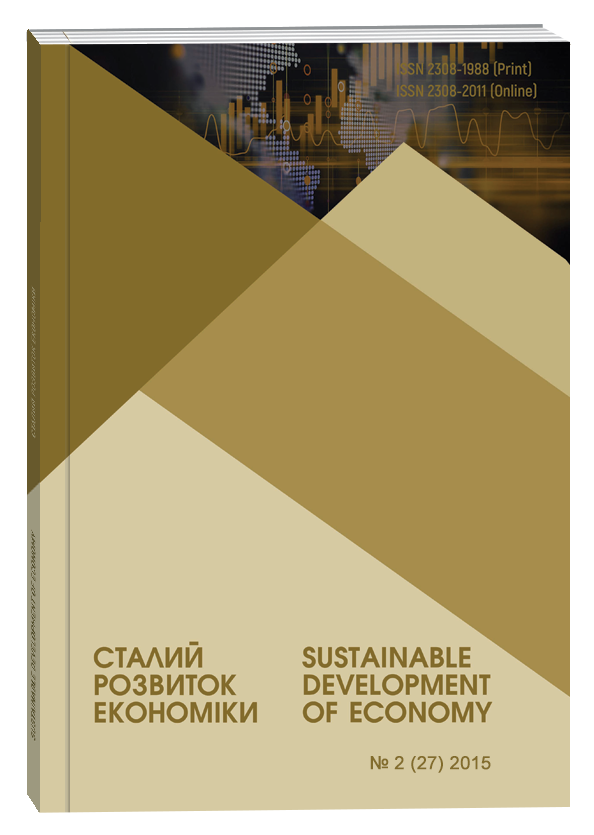PERSPECTIVE DIRECTIONS FOR TRANSFORMATION OF ENTITIES OF THE AGRICULTURAL MARKET IN CONDITIONS OF GLOBALIZATION OF ECONOMIC PROCESSES
Abstract
Purpose. The aim of the article is to determine prospective directions for further transformation of entities of the agricultural market and forming algorithms and mechanisms for their implementation. Methodology of research. Methodology of the study was based on generally accepted methods of economic researches: economic and statistical method – in studying the dynamics of the efficiency of agricultural production in Ukraine and impact of factors on the state of economic activity; monographic – for substantiation of theoretical positions of the research subject; abstract and logical – in the development of co-operative and cluster organizations of agrarian sphere, its structure and the mechanism of functioning. Findings. It has been revealed that insufficient efficiency of agricultural production in Ukraine at the modern stage of its development is largely caused by the imperfection of the organizational structure of the agricultural sector. It has been established that the large number of small producers, the lion's share of which are farms of population with dimensions up to 1 ha, makes it impossible the use of innovative products, the introduction of advanced technologies, the formation of modern material and technical base. It has been substantiated that solving of these problems is possible only through the transformation of existing forms of agribusiness in the powerful integrated structure of the market type. The proposed system of the co-operative and cluster organization of agrarian sphere able to provide the optimal scale of production, improve the level of competitiveness of domestic agricultural producers through the use of synergistic effect. Originality. The complex sectoral and territorial approach to reforming the agro-industrial sphere was used on the basis of co-operative cluster organization of economic activity, which enables to optimize the scale of production activity for the introduction of advanced technology and increase the level of management efficiency. Practical value. The obtained results of research are aimed at optimizing the scale of agricultural production, rational combination of directions for sectoral and territorial development of the agricultural sector. These results can be used to form an effective policy of local government at the level of settlement, district and region.
References
Bosworth B. Connect the dots: using cluster-based strategies to create urban employment / B.Bosworth, D.Broun // Firm Connections. – 1996. – 4(2):1–6.
Nogales E.G. Agro based clusters in developing countries: staying competitive in globalised economy Agricultural management, marketing and finance, occasional paper 25, FAO, Rome 2010.
OECD (2007) Competitive Regional Clusters – National Policy Approaches; OECD Reviews of Regional Innovation, Paris. - http://www.oecd.org/gov/regional-policy/38678677.pdf
Porter, M.E. On Competition. Cambridge, Mass.: Harvard Business School Press, 1998.
Regional clusters in Europe/ Observatory of European SMEs. – 2002 – No.3; Enterprise publications. - http://ec.europa.eu/regional_policy/archive/innovation/pdf/library/regional_clusters.pdf
Люльчак З.С. Кластеризація – спосіб підвищення конкурентоспроможності вітчизняних підприємств агропромислового комплексу та галузі, загалом / З.С. Люльчак, Х.М. Вишньовська // Вісник Національного університету "Львівська політехніка". – 2011 . – N 720. – С. 188-196.
Саблук П.Т. Засади трансформаційних процесів в аграрній сфері / П.Т. Саблук // Інтелект XXI. – 2014. – № 4. – С. 25-36.
Смоленюк Р.П. Формування кластерно-кооперативної моделі розвитку сільського господарства / Р.П. Смоленюк // Інноваційна економіка. – 2013. – № 8. – С. 17-24.
Bosworth, B. and Broun, D. (1996), “Connect the dots: using cluster-based strategies to create urban employment”, Firm Connections, no. 4(2), pp. 1–6.
Nogales, E.G. (2010), Agro based clusters in developing countries: staying competitive in globalised economy Agricultural management, marketing and finance, occasional paper 25, FAO, Rome.
OECD (2007) Competitive Regional Clusters – National Policy Approaches; OECD Reviews of Regional Innovation, Paris, available at: http://oecd.org/gov/regional-policy/38678677.pdf
Porter, M.E. (1998), On Competition. Cambridge, Mass.: Harvard Business School Press.
Regional clusters in Europe/ Observatory of European SMEs, 2002, no.3; Enterprise publications, available at: http://ec.europa.eu/regional_policy/archive/innovation/pdf/library/regional_clusters.pdf
Liulchak, Z.S. and Vyshnovska, Kh. M. (2011), “Clustering is a way to increase the competitiveness of domestic enterprises of agricultural complex and industry in general”, Visnyk Natsionalnoho universytetu "Lvivska politekhnika", no. 720, pp. 188-196.
Sabluk, P.T. (2014), “The principles of transformation processes in the agricultural sector”, Intelekt XXI, no. 4, pp. 25-36.
Smoleniuk, R.P. (2013), “Formation of cluster and co-operative model of the agriculture development”, Innovatsiina ekonomika, no. 8, pp. 17-24.


